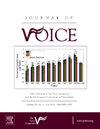非二元扬声器的明亮音质和基频变化
IF 2.4
4区 医学
Q1 AUDIOLOGY & SPEECH-LANGUAGE PATHOLOGY
引用次数: 0
摘要
目的1) 研究出生时被指派为女性(AFAB)的非二元人发出的声音变化是否与顺性别(cis)参与者发出的声音变化不同。预测非二元参与者产生的提示值与顺性别参与者产生的提示值不同。2)确定以前对 AFAB 非二元参与者的明亮声音质量的主观评估是否可以量化,如果可以量化,非二元参与者和顺性别参与者在声音质量的产生方面是否存在差异:研究设计:定量比较研究设计:研究设计:定量比较研究设计。方法:对非二元性别和双性恋参与者的连续语音样本进行语音和统计分析。声乐线索是平均基频(F0)和明亮的语音质量,以首频峰突出平滑和频谱斜率来衡量,并以说话者的性别作为预测因子:在群体层面上,非二元参与者的 F0 值处于中等水平,明显低于顺性女性,明显高于顺性男性。就个体而言,大多数非二元参与者的平均 F0 值处于中间范围。非二元参与者的负频谱斜率明显较低,倒频谱峰突出平滑度较高,这表明他们的声音更明亮、更嘹亮。个人层面的结果表明,声乐训练和声道生理并不能完全解释所发现的结果:参与者的作用,尤其是他们为避免被误用而改变声音输出的动机,会影响 AFAB 非二元参与者的 F0 输出,并可能影响他们的声音质量。大多数无双性人和无双性人参与者都独特地发出了中度 F0 和明亮音质的提示组合。本文章由计算机程序翻译,如有差异,请以英文原文为准。
Bright Voice Quality and Fundamental Frequency Variation in Non-binary Speakers
Objectives
1) To investigate if vocal variation produced by assigned-female-at-birth (AFAB) non-binary people differed from vocal variation produced by cisgender (cis) participants. Cue values produced by non-binary participants were predicted to differ from those values produced by cisgender participants. 2) To determine if previous subjective assessments of bright voice quality in AFAB non-binary participants were quantifiable, and if so, if non-binary and cisgender participants differed in their voice quality production.
Study Design
A quantitative comparative research design.
Methods
Phonetic and statistical analyses of continuous speech samples produced by AFAB non-binary and cisgender participants. Vocal cues were mean fundamental frequency (F0) and bright voice quality, measured by cepstral peak prominence-smoothed and spectral slope, with speaker gender as the predictor.
Results
At the group level, non-binary participants produced intermediate F0 values — significantly lower than the cis women's and significantly higher than the cis men's. Individually, the majority of non-binary participants produced mean F0 in this intermediate range. Non-binary participants produced significantly less negative spectral slope and higher cepstral peak prominence-smoothed, indicative of a brighter, more resonant voice quality. Individual-level results indicated that vocal training and vocal tract physiology did not fully account for the results found.
Conclusion
Participants’ agency, particularly their motivation to alter vocal output to avoid being misgendered, has an effect on the AFAB non-binary participants’ F0 production and potentially their voice quality. The majority of AFAB non-binary participants uniquely produced the cue combination of intermediate F0 and bright voice quality.
求助全文
通过发布文献求助,成功后即可免费获取论文全文。
去求助
来源期刊

Journal of Voice
医学-耳鼻喉科学
CiteScore
4.00
自引率
13.60%
发文量
395
审稿时长
59 days
期刊介绍:
The Journal of Voice is widely regarded as the world''s premiere journal for voice medicine and research. This peer-reviewed publication is listed in Index Medicus and is indexed by the Institute for Scientific Information. The journal contains articles written by experts throughout the world on all topics in voice sciences, voice medicine and surgery, and speech-language pathologists'' management of voice-related problems. The journal includes clinical articles, clinical research, and laboratory research. Members of the Foundation receive the journal as a benefit of membership.
 求助内容:
求助内容: 应助结果提醒方式:
应助结果提醒方式:


